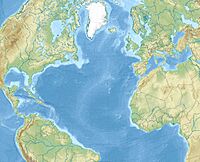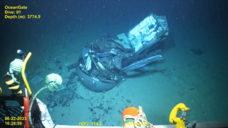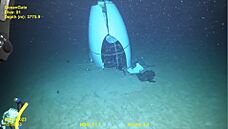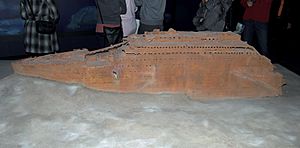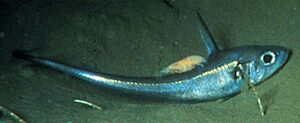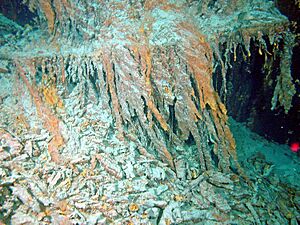Wreck of the Titanic facts for kids
Quick facts for kids Wreck of the Titanic |
|
|---|---|
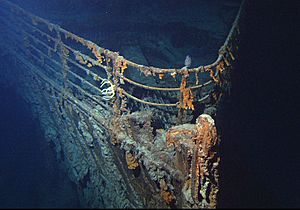
The Titanic's bow in June 2004
|
|
| Event | Sinking of the Titanic |
| Cause | Striking an iceberg |
| Date | 15 April 1912 |
| Location | 325 nmi (600 km) south-southeast of Newfoundland, North Atlantic Ocean |
| Coordinates | 41°43′32″N 49°56′49″W / 41.72556°N 49.94694°W |
| Discovered | 1 September 1985 |
The wreck of the famous British ship RMS Titanic sits at the bottom of the North Atlantic Ocean. It is located about 12,500 feet (3,800 metres) deep and approximately 370 miles (600 km) southeast of Newfoundland. The ship is broken into two main parts, the bow (front) and the stern (back), which lie about 2,000 feet (610 m) apart.
The Titanic sank on April 15, 1912, after hitting an iceberg. For many years, people tried to find the ship using sonar, but they were unsuccessful. Finally, on September 1, 1985, a team led by Jean-Louis Michel and Robert Ballard discovered the wreck. Since then, many scientists and tourists have visited the site. In June 2023, a tragic accident occurred when the submersible Titan was lost near the wreck.
Thousands of items have been recovered from the debris field around the ship and are shown in museums. Because the ship has been underwater for over 100 years, it is becoming very fragile. Metal-eating bacteria are slowly destroying the hull, and scientists believe the wreck may eventually collapse completely. It is now protected by a UNESCO agreement to keep it safe.
Contents
Early Ideas to Save the Titanic
Right after the Titanic sank in 1912, people wanted to bring it back to the surface. However, nobody knew exactly where it was or how deep the ocean was at that spot. The water pressure there is crushing—about 400 times stronger than the air pressure at sea level.
Over the years, people came up with many strange ideas to raise the ship:
- Magnets: In 1914, an architect suggested using huge electromagnets to pull the steel hull up to a submarine.
- Balloons: Another idea was to attach magnets and balloons to the hull to float it to the surface.
- Ping-Pong Balls: In the 1970s, someone suggested filling the ship with millions of ping-pong balls. Unfortunately, the water pressure would have crushed the balls instantly.
- Iceberg: One plan involved freezing the water around the ship to turn it into a giant iceberg that would float up. This would have required half a million tons of liquid nitrogen.
None of these plans worked because the technology did not exist, and it was too expensive.
Discovery of the Wreck in 1985
By the 1980s, technology had improved. Robert Ballard from the Woods Hole Oceanographic Institution wanted to find the Titanic. He worked with the United States Navy on a secret mission to find two lost nuclear submarines. Once that mission was done, he had 12 days left to search for the Titanic.
Ballard used a camera sled called Argo that was towed behind his ship. Instead of looking for the big ship directly, he looked for the trail of debris (trash and broken pieces) that fell from the ship as it sank. This trail was much bigger and easier to spot.
On September 1, 1985, the team saw debris on their video screens. Soon after, they spotted a massive boiler. They had found the Titanic! The discovery made news all over the world.
Exploring the Shipwreck
Early Expeditions
In 1986, Ballard returned with a submersible called Alvin that could carry people. He also used a small robot named Jason Jr. to go inside the ship. They took amazing photos of the Grand Staircase and chandeliers that were still hanging from the ceiling.
Other teams visited later. In 1987, a French team began bringing up artifacts like plates and jewelry. In 1995, film director James Cameron visited the wreck to film footage for his famous movie Titanic.
The Titan Accident
In recent years, tourists began paying to visit the wreck in small submersibles. In June 2023, a submersible named Titan, operated by the company OceanGate, went missing during a dive. Sadly, it was later discovered that the vessel had imploded (collapsed inward) due to the extreme pressure, and all five people on board died. This tragedy reminded everyone how dangerous deep-sea exploration can be.
Recent Studies
In 2024, a new expedition visited the site to take high-resolution photos. They wanted to see how much the ship had changed. They found that a section of the railing on the bow, famous from the movie scene where Jack and Rose stand at the front of the ship, had fallen off.
What the Wreck Looks Like
The Titanic is broken into two main pieces that lie on the ocean floor.
The Bow (Front)
The front part of the ship, the bow, is the most famous. It is about 470 feet (140 m) long. When it hit the sea floor, it plowed into the mud, burying the bottom part. Despite the crash, the bow is still recognizable. You can see the anchor cranes and the railing. Inside, some rooms are surprisingly well-preserved. The Grand Staircase is gone, leaving a large hole that submersibles can use to enter the ship.
The Stern (Back)
The back of the ship, the stern, is in terrible shape. As the ship sank, air trapped inside the stern caused it to explode and break apart. When it hit the bottom, it crumpled like a piece of paper. It is now a pile of twisted metal and decks pancaked on top of each other. It is very hard to recognize specific rooms in this section.
The Debris Field
Between the two sections lies a huge field of debris. This area is full of items that spilled out of the ship, including:
- Thousands of pieces of coal
- Suitcases and clothes
- Dishes, cups, and wine bottles
- Furniture like bathtubs and bed frames
- Pieces of the ship's hull
Science and Rusticles
When the wreck was first found, scientists were surprised to see life at such a depth. They found fish, crabs, and starfish living on and around the ship.
The most interesting discovery was a new type of bacteria called Halomonas titanicae. These bacteria eat iron. As they eat the steel of the ship, they form rust-colored icicles called rusticles. These rusticles hang from the hull and look like melting chocolate. They are very fragile and turn into dust if touched.
Because of these bacteria, the Titanic is slowly disappearing. The bacteria eat about 400 pounds (180 kg) of iron every day. Scientists estimate that the ship's structure might collapse completely within the next few decades. The famous captain's bathtub, which was visible for years, is now buried under falling debris.
Artifacts and Museums
Since the discovery, thousands of objects have been brought to the surface. These include:
- A pocket watch that stopped at the time of the sinking
- Musical instruments
- Jewelry and money
- A large piece of the ship's hull called "The Big Piece"
There is a big debate about whether it is right to take things from the Titanic.
- Conservationists believe we should save these items to teach history and display them in museums.
- Protectionists believe the wreck is a grave site for the 1,500 people who died and should be left alone out of respect.
Today, you can see Titanic artifacts in museums in places like Halifax, Nova Scotia, Liverpool, and Las Vegas.
Images for kids
See also
- The Big Piece, the largest piece of the Titanic's wreck to be recovered
- The Titanic disaster
- RMS Titanic Maritime Memorial Act
- Agreement Concerning the Shipwrecked Vessel RMS Titanic


